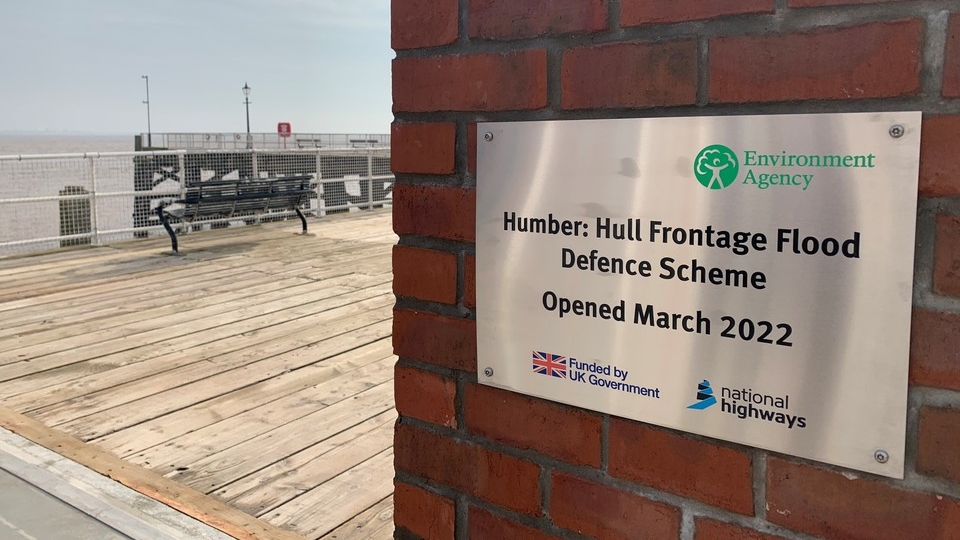The £42 million scheme is an investment that makes the city more resilient to the impacts of climate change.
On 5 December 2013, the east coast experienced a serious tidal surge, causing devastating flooding in Hull and communities along the banks of the Humber. The highest ever tide (5.8m) was recorded at the Hull Barrier.
The Humber: Hull frontages flood defence scheme, is just one of a series of projects that have been completed to help reduce flood risk in and around Hull, and make communities more resilient to flooding. Funding for the scheme to upgrade the tidal flood defences along the estuary shoreline of the city came from Defra’s Flood Defence Grant in Aid with a £3 million contribution from Highways England (now National Highways).

The defences now provide a standard of protection that reduces flood risk to a 0.5 per cent chance in any given year. Massive in scale, the project covers around 7km of shoreline, out of a total frontage length of about 12km, from St Andrew’s Quay Retail Park in the west, through St Andrew’s Dock, William Wright Dock, Albert Dock, Victoria Pier and through Victoria Dock Village in the east.
Construction work by contractors BMMJV, BAM Nuttall and Mott Macdonald, started in the St Andrew’s Quay Retail Park in January 2019 following completion of the design, and major works were finished in December 2021.
The project connects with other flood defence improvements which have been built along the Humber by East Riding Council; east of Hull at Paull and to the west of the city at Hessle.
The project is being officially opened by the chair of the Environment Agency, Emma Howard Boyd and Minister Rebecca Pow.
Rebecca Pow, Floods Minister, said: ” This scheme – supported by £39 million of Defra funding – is a crucial step forward in helping to prevent a repeat of the devastating flooding in 2013 and ensuring that Hull is resilient to the effects of climate change.
” We have invested more in Yorkshire and the Humber than any other region – with over £146 million allocated for investment in new flood and coastal defences this year, and over half a billion pounds invested since 2015.”
Emma Howard Boyd, chair of the Environment Agency, said: “This week, the IPCC released its most severe warning yet about the impacts of climate change but our response should not only be about avoiding shocks, threats and risks, it’s about creating a fairer, greener, more prosperous future.
” The Humber Hull Frontage scheme provides better protection for thousands of homes, businesses, and agricultural land. This should generate additional investor confidence and provide greater economic prosperity and job security in the area. I am particularly pleased that, as we relied on local labour for construction, this opened up opportunity for apprentices to work on the scheme and find full time employment.”

The Environment Agency worked in partnership with Hull City Council, to use materials and a colour palette to blend the new defences into the existing landscape. This was particularly important in residential areas and areas of cultural significance to the city.
Glazed panels in the flood walls at several locations maintain estuary views from the footpaths running parallel to the estuary which form part of the popular Trans Pennine Trail, as well as from homes at Victoria Dock Village.
Councillor Daren Hale, leader of Hull City Council, said: “The opening of these state-of-the-art flood defences is critical to the regeneration of Hull.
“Since 2007, the city has seen more than £200m invested in its flood infrastructure, born out of the success of the Living with Water partnership and Hull being a Global Water Resilient City. The investment along the Humber Frontage is arguably the most important, given the effects of climate change and Hull being the second most flood-prone city in the UK.
“We are delighted with the way the Environment Agency’s design team has worked with Hull City Council, as well as local residents and businesses, to ensure the scheme complements, in particular, the Fruit Market and Victoria Dock areas of the city. The clever use of brick cladding and screens retains the linkage between the city and the water in a way that responds well to the existing environment.
” The investment in flood defences has been central in enabling both Siemens Gamesa and Reckitt to invest in the city, and also to the regeneration of the Fruit Market and the city centre.”
With the increasing impact of climate change, it is impossible to completely stop the risk of flooding. The Environment Agency is working with other organisations to help mitigate current and future flood risks.
The scheme was part of the Environment Agency’s previous six-year programme of capital flood defence schemes, which has successfully protected more than 314,000 homes since 2015.
Last year, a record £5.2 billion government investment to create around 2,000 new flood and coastal defences and better protect 336,000 properties across England was announced.



